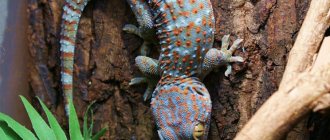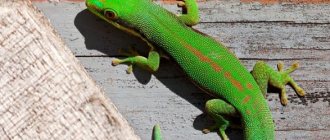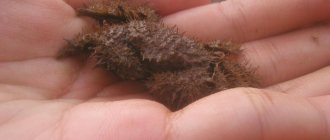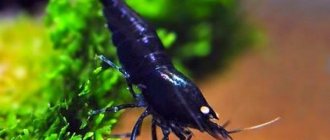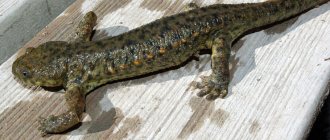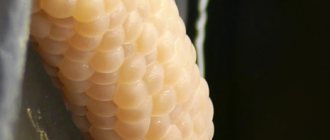The eyelashed banana-eater gecko (lat. Rhacodactylus ciliatus) was considered a rare species, but is now quite actively bred in captivity, at least in Western countries. He is originally from New Caledonia (a group of islands between Fiji and Australia). The banana-eater gecko is well suited for beginners, as it is unpretentious and interesting in behavior. In nature, they live in trees, and in captivity they look great in terrariums that reproduce nature.
Heating and lighting
The body temperature of reptiles depends on the temperature of the environment, so it is important to maintain comfortable conditions in the terrarium. A thermometer is required, or better yet two, in different corners of the terrarium.
Banana-eating geckos like temperatures of 22-27°C during the day. At night it can drop to 22-24°C.
To create this temperature, it is best to use special lamps for reptiles.
Other heaters are not suitable because eyelash geckos spend a lot of time at altitude and a heater at the bottom of the terrarium will not warm them.
The lamp is placed in one corner of the terrarium, the second is left cooler so that the gecko can choose a comfortable temperature.
The length of daylight hours is 12 hours; the lamps are turned off at night. As for ultraviolet lamps, you can do without them if you provide additional food with vitamin D3.
Content Features
A young gecko can be kept in a terrarium with a volume of at least 50 liters, always with a lid. For an adult, you will need a space of 100 liters, also closed at the top. A container of 40x40x60 cm is suitable for a couple. One male and a pair of females can be kept in one terrarium. You cannot place two males together; they will start fighting for territory.
The banana-eater gecko is unpretentious, but certain conditions of detention will have to be observed. Let's start with the temperature regime. During the day it should be from 25 to 30 degrees, at night - from 22 to 24. Overheating for a gecko is just as dangerous as hypothermia; it can cause stress to the pet and even die. The terrarium can be heated using a thermal mat, a thermal cord or a regular lamp. As for ultraviolet irradiation, it is optional, since the banana eater is awake at night.
Another essential requirement is humidity. It should be maintained at a level of 60 to 75%. This can be achieved by spraying the terrarium with a spray bottle in the mornings and evenings. The water must be clean, as geckos love to lick it from the walls of their “home”. Plants that can be placed directly in pots or planted in a substrate help maintain a high level of humidity. It is better to install a hygrometer in the terrarium.
The ideal soil for a gecko is soil mixed with peat in a one to one ratio. This substrate is sprinkled with fallen leaves on top. Can be replaced with coarsely crushed coconut, tree bark mulch or plain paper.
Substrate
Geckos spend most of their lives above ground, so the choice is not critical. The most practical are special mats for reptiles or just paper.
If you plan to plant plants, you can use soil mixed with coconut shavings.
Banana-eating geckos naturally live in trees, and similar conditions must be provided in captivity.
To do this, add branches, driftwood, large stones to the terrarium - in general, anything they can climb on.
However, there is no need to clutter it either; leave enough space. You can also plant living plants, which in combination with driftwood creates a magnificent, natural look.
It could be ficus or dracaena.
Pet food
In nature, lizards feed on fruits and small insects. At home, you can feed your pet lizard food, which can be purchased at a pet store. Or you can develop your own menu. Suitable food items include grasshoppers, locusts, and cockroaches. You just need to be careful about the size of the insect; if the insect is large, then the pet will not be able to swallow it, because the lizard does not know how to chew. The need for fruit is provided by fruit puree, which can be:
- apricot;
- banana;
- plum;
- peach.
A small lizard needs to be fed every day, an adult 3 times a week. There should always be a drinking bowl with clean water in the terrarium.
Care and handling
In the wild, eyelashed banana-eating geckos lose their tails and live with a stubby stub.
We can say that this is a normal state for an adult gecko. However, in captivity you want to have the most spectacular animal possible, so you need to handle it carefully and don’t grab it by the tail!
Once purchased, do not disturb geckos for a couple of weeks or more. Let them get comfortable and start eating normally.
When you start picking it up, don’t hold it for more than 5 minutes at first. This is especially true for children, they are very sensitive and fragile.
Banana eaters don't bite much, I pinched them and let them go.
What to feed?
The banana-eater gecko is omnivorous; both animal and plant foods are suitable. The only thing you need to remember is that this species has a specific jaw structure, which is why it cannot swallow too large pieces.
The following live foods are suitable for geckos:
- Feeding cockroaches.
- Cricket is the best option.
- Zoophobas is not very preferable due to its large size.
From plants:
- Various fruit purees.
- Fruits, cut into small pieces.
Citrus fruits should not be given to a banana eater.
Animal and plant foods should be combined in a 1:1 ratio. But it’s not always easy to feed your pet fruit; often they only choose bananas.
The eyelash gecko must be given a mineral and vitamin supplement containing calcium and vitamin D3 for its absorption. To get your pet to eat it, you can roll the insects in the mixture before serving. It is better to place food in a special feeder rather than on the ground, as its particles can stick to the piece and enter the gecko’s digestive tract.
Do not forget that there should always be clean and fresh water in the terrarium.
What he eats?
Our gecko eats live crickets. I buy them at Papa Carlo on Profsoyuznoy and at Gekko.Ru on Semenovskaya
Gekko always has a better selection (important: delivery on Wednesdays), but the store is too far from us. You can also feed frozen crickets with tweezers, but mine categorically refuses to eat carrion
I usually take 20-30 crickets and put them in a trimmed (no, they don’t jump out) five-liter canister with newspaper (so that there is room for them to crawl). I feed him carrots (this will only make Ben feel better). They can live like this for two weeks. I try to buy smaller ones (they recommend a size equal to the distance between your gecko’s eyes). Before serving to my crocodile, I roll it in a vitamin mixture with calcium. I put the crickets in the terrarium in a small plastic box so that the crickets don’t immediately run away and Benya can easily attack them. However, he can easily catch those who have run away (even if not the first time).
The diet helps to diversify children's fruit puree (banana-apple) and the banana itself. It is believed that banana eaters (for nothing they called them that!) can eat them endlessly, but a lot of bananas are harmful, so I don’t give them too often. Sometimes I try to feed him puree while walking - he eats it. And the puree is also eaten by crickets that have escaped from the feeding box.
Vitamins and calcium are essential. Otherwise, the comrade will not stick well to vertical surfaces. Hence the nerves, stress and tail drop (see above).
Reproduction
Sexual maturity in banana eaters occurs after a year. In this case, males mature several months earlier than females. However, young geckos should not be allowed into breeding, as this is especially harmful to the health of the female. It's best to wait until she's two years old.
A male and several females are placed together. Fertilization occurs at night. A pregnant female must be separated from the male immediately, otherwise he may harm her. When safe, the lizard will lay and bury two eggs in the ground. The incubation period ranges from 55 to 75 days. The temperature should be between 22 and 27 degrees.
Ciliated banana beetle
This is a bright and quite interesting representative of the gecko family. The ciliated banana-eater lives in forests with high humidity - the tropics. The lifestyle is mainly arboreal. It comes down to the ground very rarely. This species was considered extinct long ago until it was rediscovered in 1994 in New Caledonia. Nowadays, the ciliated banana-eater gecko is quite often found in the collections of some terrariumists. An adult can reach 22 cm in length. On average, the size of this representative of the flailfoot is 16-18 cm.
The banana eater has an elongated body that smoothly turns into a tail. By the way, it disappears from the gecko. But the absence of a tail does not in any way affect the further life of the banana eater. An elongated triangular head, a tongue with a slit, large eyes without eyelids... Small outgrowths similar to eyelashes are observed around the eyes. Because of this external feature, the creature received its name - “ciliated banana-eater”. The second factor that determined such an interesting name is, so to speak, culinary. Yes, this type of gecko eats bananas. This can be said to be his favorite food. In addition, it eats various insects, preferably crickets. And also will not refuse any fruits that are not citrus fruits.
Can banana eaters change color?
Banana eaters can change their color. Discoloration can only be caused by aging. Cubs and juveniles usually have a different or different shade than when they are adults. Another process of color change is when they are exposed to certain environmental influences. This process depends on various factors.
Banana eaters are limited in their ability to change color and cannot do so at will. They will change color as they grow or when they are exposed to certain environmental influences. There is also another way your gecko's color may change temporarily, the molting cycle.
In this article, you will learn why the banana beetle changes its color and what environmental conditions can cause the color change.
Why do banana-eater crested geckos change color?
There are three reasons why your gecko may change its color:
- ontogenetic (age-related) color change
- change in color of the environment (ignition)
- color change due to shedding
· Age-related color change
- Banana eaters are born bright orange or red, and it is impossible to determine the adult color in the first few months. Your baby or teen will not change color overnight, it will take several months to see the final color.
- When your banana eater is about 1 year old, the adult color will be established. It may be a completely different color than the one the cub had. Like color, patterns are also associated with age. The hatchling will have few or no spots, but as it matures, stripes and spots will appear.
Color change due to environment
Even adult banana eaters can still change their color, depending on many different factors. You may be exposed to certain environmental conditions that may cause the color change.
The most common reasons for a gecko to change color are:
- stress, fear, aggression: all of these moods can cause a gecko to change color. The stress and fear response can be caused by a new environment, poor living conditions, overcrowding or even reproduction.
- High Humidity: Higher humidity around 70 percent may cause discoloration. These humidity levels usually occur at night or in the morning.
- high temperature: Temperatures around 80 degrees Fahrenheit can cause the gecko to change color. Just be sure not to expose them to high temperatures (above 85 degrees Fahrenheit) for long periods of time, as this may cause overheating.
- Light (or lack of light): Banana eaters often change color at night when there is little light. This may be a way to hide from predators by producing darker colors.
- Activity: Sleeping geckos usually have a duller color. When your banana beetle becomes active at night, it usually darkens.
Some of these reasons are interrelated. High humidity often occurs at night when there is little light and when your banana eagle is active. It is not always possible to attribute color changes to one specific environmental trigger.
· Change in color due to shedding
Banana eaters, like other reptiles, shed their old skin and replace it with new skin. A few days before she begins to shed, you will notice that your banana eater turns gray or even pale. This is completely normal and there is no reason to worry. Your banana eater will shed its skin and return to its normal color in a few days.
Behavior
Fantastic leaf-tailed gecko
The reptile was jokingly nicknamed the teleporter – it’s interesting to watch. Mobile, nimble, jumps from branch to branch, quickly climbs a vertical surface. The tenacious limbs and flat part of the tail are covered with microscopic hairs - due to them, a reliable grip is formed on a sheer wall, including a glass one.
The species is distinguished by distrust of humans. An unfriendly pet is picked up only if necessary, for example, to monitor its health. Experienced terrarium keepers gradually accustom wild animals using the “hand-to-hand” method. They are presented to the gecko and wait for him to drop by. This way you can increase the contact time from five to twenty minutes. Socialization takes months, you need to be patient.
The owner's obsessive desire to cuddle leads to the loss of the tail. Stress causes a reflexive contraction of muscles and throwing away a protruding part of the body. There is no bloodshed - the walls of the blood vessels contract sharply. This is how a reptile saves its life in nature. A new one does not grow, but the lizard gets along without it, without grieving over the loss.
Shedding period
The eyelash gecko sheds about once a month. The beginning of this period is accompanied by lethargy, and the lizard’s skin takes on a dull grayish tint. After shedding, your pet may eat the shed skin; this is completely normal. To successfully complete this period, it is necessary to maintain high humidity in the terrarium - at least 70%
This is especially important for young animals, whose condition must be constantly monitored.
If the air is not humid enough, molting may not proceed properly. Then pieces of skin will remain between the babies, near the eyes and on the tail. Over time, this will cause the toes and tail to die. These consequences can be easily avoided. To do this, the lizard is placed in a container of water for about half an hour. The temperature of the liquid must be constantly maintained at 28 degrees. After this, the skin must be removed using tweezers.
Where does he live? What conditions should such a gecko have?
At first, Benya lived in the wrong plastic terrarium (he didn’t quickly find a suitable home), but pretty soon he acquired an excellent mansion - the vertical glass terrarium EXO-TERRA. It is convenient to crawl on the vertical terrarium, and the size (45*45*60) allows you to jump wildly. Although such a terrarium is considered large and even three banana-eaters can be placed in it, I am not yet ready to increase the number of pets.
